Hurtling into battle with guns spitting death, wings of combat aircraft fight their own war high above the battlefield. Whether bombers laden with explosive weaponry, agile fighters ready to blast their enemies from the sky, or versatile ground attack gunships, these craft operate in Flyer Wings and adopt deadly Attack Patterns to maximise their might. Flyer Wings are aircraft units whose crews have fought alongside each other in numerous campaigns. The pilots of the separate aircraft have developed an innate ability to anticipate what their comrades are about to do, allowing them to maximize the eect of their attacks, or ensure their survival when return re comes their way.Flyers can either operate on their own as single models, or be taken in a Flyer Wing of between two and four models. All of the models in a Flyer Wing must be chosen from the same datasheet or be part of the same Formation. Write down the Flyer Wings you will be using in your army on your force roster when you have finished selecting your army (see Warhammer 40,000: The Rules). Flyers that are part of a Flyer Wing are treated like normal units, with a few exceptions and clarications that are described below. When a Flyer Wing is deployed, one of its vehicles must be nominated as the Wing Leader. The Wing Leader is the most experienced pilot in the group, and they receive a special Wing Leader ability to represent their exceptional skills. Only make one Reserve Roll for all of the Flyers in a Flyer Wing. They either all arrive, or none do. In addition, when they deploy, each Flyer in the Wing must be set up within 4" of at least one other model from the Flyer Wing, following the rules for Vehicle Squadron coherency described in Warhammer 40,000: The Rules. Unlike other units, however, following their deployment, each Flyer in a Flyer Wing operates as an individual unit. Flyers never block the line of sight for other Flyers from their own Flyer Wing (they are in constant communication, and roll or bank to open ring lanes for their comrades). Although the Flyers in a Flyer Wing operate independently and do not have to maintain unit coherency, if a Flyer Wing ends a Movement phase in one of the Attack Patterns listed on the following pages, then it will benet from a special rule. Because of this, you will nd that it usually pays o to keep the models in a Flyer Wing within close proximity of each other. Each Attack Pattern has a pattern diagram, that shows how many Flyers must currently be in the Flyer Wing in order for it to use the pattern, and how the models in the Flyer Wing must deploy, or nish a move, in order to be in the Attack Pattern. The special rule that applies is described with the Attack Pattern. Note that a Flyer’s Combat Role aects the special rules it receives, so a Bomber will receive dierent benets to a Fighter or Attack Flyer, for example. Once a special rule has been triggered, it applies until the end of the Flyer Wing’s next Movement phase, even if its models subsequently end up out of pattern, or if any of the models in the Flyer Wing are destroyed. Should the Flyers be positioned in such a way as to be eligible for two or more Attack Patterns, you must declare which one it will use. A lone pilot faces myriad threats, from the unseen enemy that shoots down a fighter ace even as they line up their own killing shot, to the missile that punches a bomber from the air before it can release its payload. It is for this reason that many smaller squadrons adopt the Vigilance pattern, one pilot watching over another while they complete their mission. A Vigilance Attack Pattern is a dedicated escort grouping. It allows the lead craft to concentrate upon attacking the enemy, while their escort – the vigilant – makes sure that they are warned of any enemy attacks.A Flyer Wing must have two models to adopt a Vigilance Attack Pattern, and the Flyers must be in the pattern shown in the diagram below. Both must be facing in the same direction. 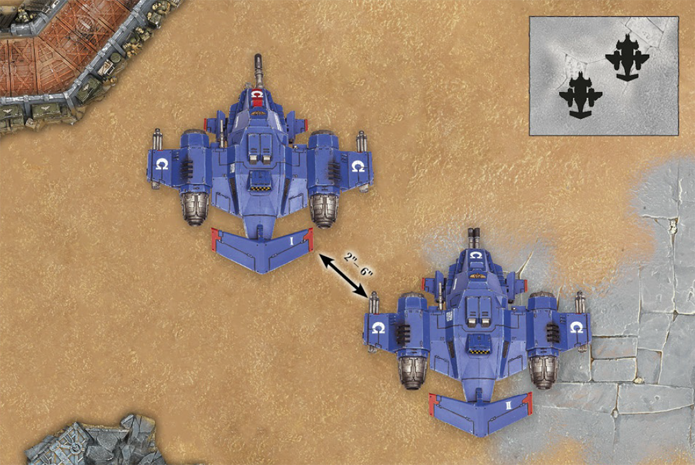
The Vehemence Attack Pattern is highly aggressive. It is commonly used when the target lies dead ahead, and a thunderous attack run is needed to seal their demise. Screaming down upon their victim in a tight ‘V’ pattern, the squadron opens fire as one, tearing the target apart in a maelstrom of destruction. A Vehemence Attack Pattern allows the Wing Leader to feed targeting information back to the other craft in the group, allowing them to strike repeatedly at an enemy’s weak points. The pattern is especially eective when it is used to target enemy vehicles.A Flyer Wing must have three models to adopt a Vehemence Attack Pattern, and the Flyers must be in the pattern shown in the diagram below. All must be facing in the same direction. 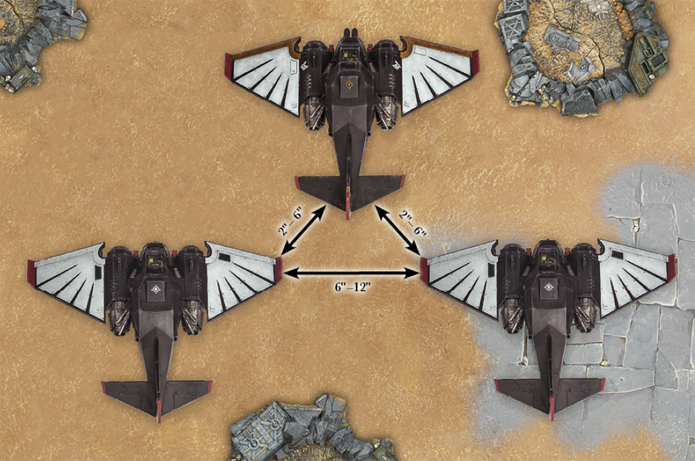
This Attack Pattern is used when a squadron’s prey is on the run, or has gone to ground in the hopes of hiding from their attackers. Rather than allow their enemy to escape unpunished, the aircraft fall into a staggered line, overlapping their fire and correlating their targeting so as to strip the enemy of their protection. The Wing Leader in an Intolerance Attack Pattern can pinpoint enemy positions and flight patterns, allowing the group to strike in such a way that the benefits of any cover or evasive manoeuvres are negated. Bombers and Attack Flyers use this pattern to winkle out dug-in enemy ground troops, while Fighters use it against Flyers that are trying to evade their guns. A Flyer Wing must have three models to adopt an Intolerance Attack Pattern, and the Flyers must be in the pattern shown in the diagram below. All must be facing in the same direction.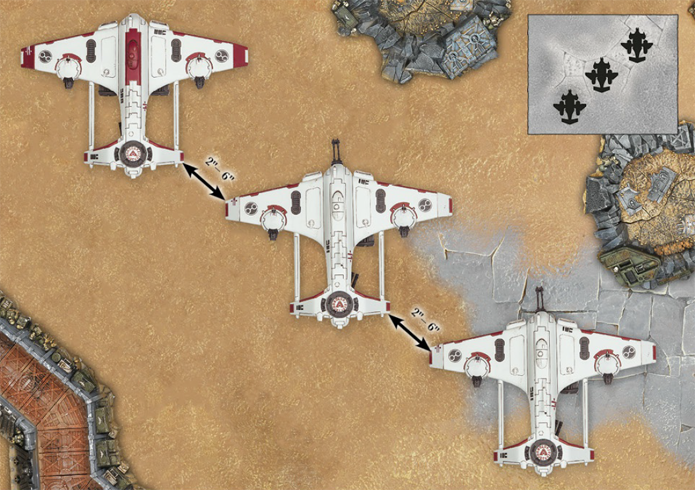
When a single target must be destroyed at all costs, the Unmerciful Attack Pattern is the perfect deployment. One by one, the squadron’s aircraft hurtle low over their enemy, each hammering them with successive volleys of firepower. With every pass the attackers’ fire becomes more accurate, and their victims’ casualties more horrific. Flyers in an Unmerciful Attack Pattern can move very quickly, as they only have to follow the Flyer in front of them rather than trying to maintain their pattern. In addition, they can launch a succession of increasingly accurate attacks against the same target.A Flyer Wing must have three models with the same Combat Role to adopt an Unmerciful Attack Pattern, and the Flyers must be in the pattern shown in the diagram below. All must be facing in the same direction. 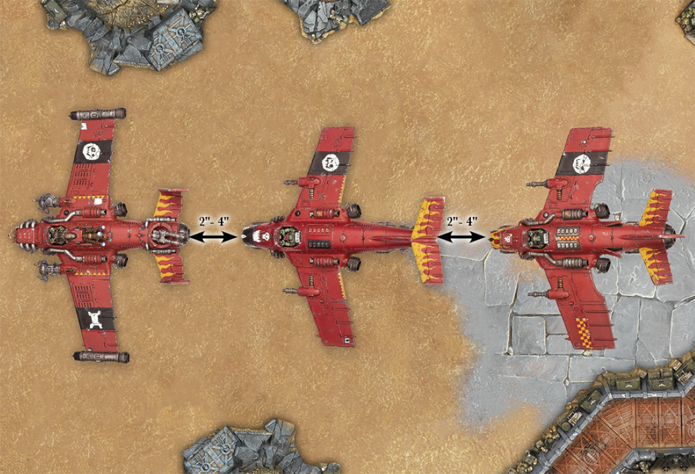
Arguably the most versatile Attack Pattern in common use above the battlefields of the 41st Millennium, the Indomitable Attack Pattern allows large aircraft squadrons to rule the skies uncontested. Combining the benefits of several smaller patterns in one, this deployment forges a wing of aircraft into an airborne weapon of total domination. The Indomitable Attack Pattern is incredibly exible, oering the Flyers in the group the benets of several smaller Attack Patterns from a single pattern. This makes it one of the most popular Attack Patterns for Flyer Wings that are large enough to be able to utilise it.A Flyer Wing must have four models to adopt an Indomitable Attack Pattern, and the Flyers must be in the pattern shown in the diagram below. All must be facing in the same direction. 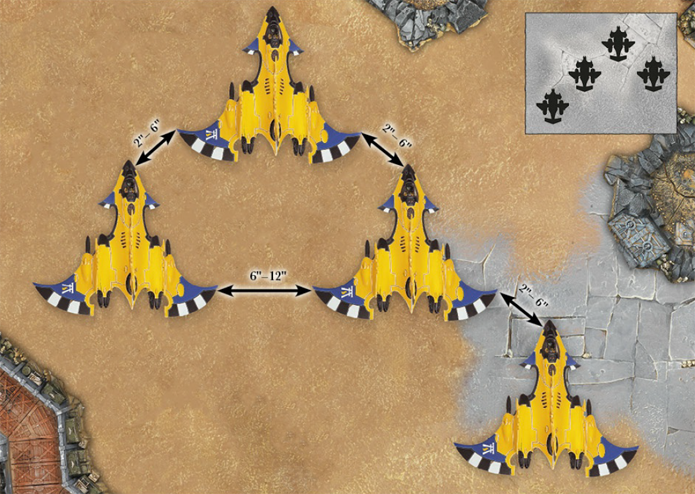
None can hide from the all-seeing eyes of pilots in an Omniscience Attack Pattern. Cast high over the battlefield like an inescapable net, the squadron gathers detailed intelligence on their enemies, triangulating targeting data and divining their victims’ hidden weak points. By the time the aircraft scream down to attack, they know precisely where to strike. Flyers in an Omniscience Attack Pattern can pool their targeting data, allowing them to launch devastating attacks upon a common target. The Omniscience Attack Pattern is especially useful when massed enemy units of the same type are rst encountered, as the information gathered can be used by the Flyers for the rest of the mission. A Flyer Wing must have four models to adopt an Omniscience Attack Pattern, and the Flyers must be in the pattern shown in the diagram below. All must be facing in the same direction.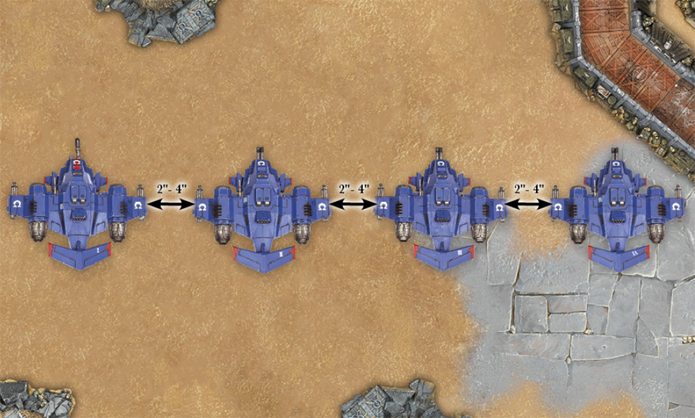
Amid the close-packed spires of urban war zones or in skies swarming with predatory monstrosities, sudden death can threaten from any quarter. In such situations, larger wings of aircraft adopt the defensive Fortitude Attack Pattern. Popular with bombers and gunships alike, this flying fortification allows all pilots to guard one another from harm. The Fortitude Attack Pattern is a powerful defensive deployment that can be used by large Flyer Wings that are entering an especially heavily-defended danger zone. The tight grouping allows the Flyers to protect and ward each other against enemy attacks, and unleash deadly coordinated return re against enemy Flyers that attempt to engage them. A Flyer Wing must have four models to adopt a Fortitude Attack Pattern, and the Flyers must be in the pattern shown in the diagram below. All must be facing in the same direction.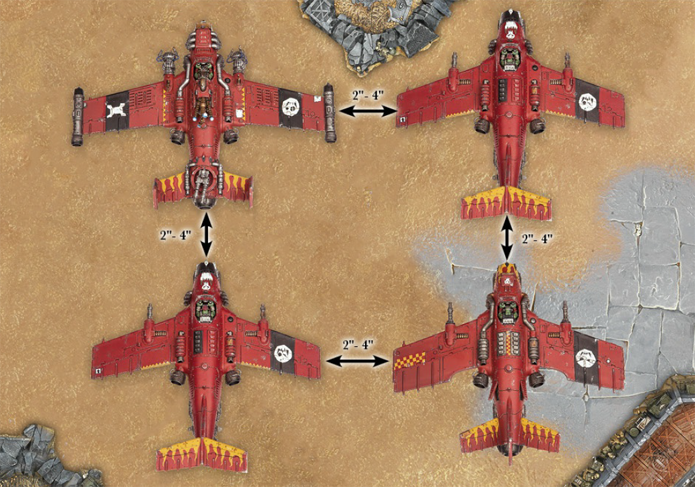
|
Expansions > Death from the Skies >

